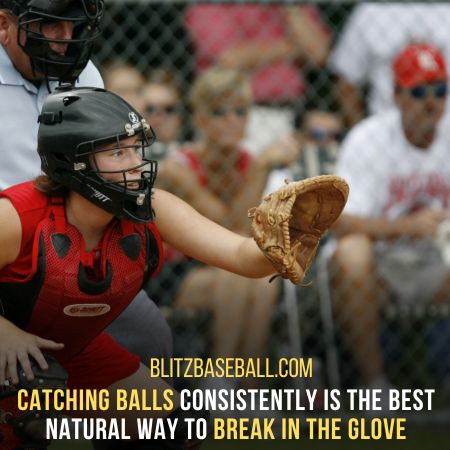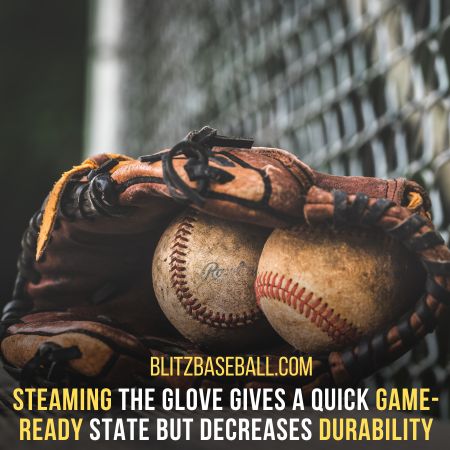Every player needs to know how to break in Wilson A2000 outfield glove. The process of breaking in a Wilson A2000 outfield glove is a crucial step for baseball players in order to optimize its usability and improve ball-catching abilities.
New leather gloves are initially rigid and challenging to manipulate, necessitating the need for a break-in period to soften the material.
Nomar Garciaparra, an elite player, exemplifies the effectiveness of consistently catching balls with the glove to achieve a perfect fit and enhance performance.
Additionally, employing methods such as pouring warm water into the glove’s palms and pockets, squeezing the heel pad, and utilizing a mallet for stretching can aid in the break-in process.
The application of approved glove oils and conditioners is another viable approach to soften the glove, although moderation is advised.
However, caution must be exercised to avoid utilizing harmful methods like the oven technique or shaving cream, as these can damage the glove.
Furthermore, flaring the glove for infield positions can augment performance, while overnight breaks or the mattress method are not recommended for long-term durability and optimal performance.
It is essential for players to adhere to approved and natural methods to effectively break in a Wilson A2000 outfield glove.
Key Takeaways
- Break in means making new gloves ready for use
- Catching balls consistently is the best natural way to break in the glove
- Using glove oil and conditioner softens the glove
- Steaming the glove gives a quick game-ready state but decreases durability
How To Break In Wilson A2000 Outfield Glove
The breaking-in process is a crucial step that baseball players must undertake to soften and improve the usability of their Wilson A2000 outfield gloves, as pre-existing knowledge suggests. To break in a Wilson A2000 outfield glove, there are various techniques and alternative methods available.
The most natural and recommended method is to consistently catch balls with your own hand. This allows the glove to gradually soften and form to your hand, resulting in improved performance. Elite players like Nomar Garciaparra follow this method to ensure optimal glove fit and functionality.
Additionally, some players may choose to break in their gloves using hot water. In this method, warm water is poured into the glove’s palms and pockets, followed by squeezing and stretching the glove.
Another option is to use glove oil and conditioner. This involves applying a small amount of oil and conditioner and rubbing it with a clean cloth.
It is important to avoid using excessive force or chemicals, as well as methods like using the oven or microwave, which can damage the glove.
Natural Break-In Methods
Catching balls consistently with one’s own hand is considered the best natural method for breaking in a Wilson A2000 outfield glove. This method allows the player to soften the glove and form it to their hand, resulting in improved performance and durability.
Elite players like Nomar Garciaparra follow this technique to ensure the optimal functionality of their gloves.

Additionally, the flaring technique can be utilized to create a larger flat surface and a shallow pocket, ideal for infielders who need to quickly move the ball and make efficient throws.
However, it is important to note that there are no effective overnight break-in methods for Wilson A2000 gloves. Quick methods like steaming or using the oven may provide immediate usability, but they can compromise the glove’s long-term durability and performance.
Using Hot Water
Pouring warm water into the palms and pockets of a leather glove can help soften the material and make it more pliable. This method of breaking in a Wilson A2000 outfield glove is a popular choice among baseball players.
The warm water helps to relax the stiff leather, allowing it to mold more easily to the player’s hand. It is important to use warm water, as hot water can damage the leather and affect the glove’s performance.
In addition to using warm water, players can also use a glove mallet to further soften the glove. The mallet is used to repeatedly strike the pocket of the glove, helping to break down the leather fibers and create a more flexible pocket.
Proper glove care is essential to maintain the longevity and performance of the Wilson A2000 outfield glove.
Using Glove Oil and Conditioner
Using approved oils and conditioners can help soften the leather of a baseball glove and improve its flexibility and performance. When it comes to breaking in a Wilson A2000 outfield glove, using glove oil and conditioner can be an effective method. Here are some benefits of using glove oil and conditioner:
-
Softening the leather: These products can help soften the stiff leather of a new glove, making it easier to squeeze and manipulate.
-
Maintaining moisture: Glove oil and conditioner help keep the leather moisturized, preventing it from drying out and becoming brittle.
-
Increasing durability: By moisturizing the leather and preventing cracking, glove oil and conditioner can help prolong the lifespan of a glove.
-
Lubricating the leather: Applying oil and conditioner can lubricate the leather, reducing friction and allowing for smoother movements and catches.
To properly apply glove oil and conditioner, it’s important to use approved products and follow these techniques:
-
Use a small amount: Applying too much oil or conditioner can saturate the leather and lead to damage. Use a small amount and gradually add more if needed.
-
Rub with a clean cloth: Gently rub the oil or conditioner into the leather using a clean cloth. This helps distribute the product evenly and allows it to penetrate the leather.
-
Avoid the web: Do not apply oil or conditioner to the webbing of the glove, as it can make the pocket too soft and affect the glove’s performance.
By following these proper application techniques, players can effectively break in their Wilson A2000 outfield glove and enhance its performance on the field.
Wrapping the Glove
The process of wrapping a baseball glove involves folding the glove from the pinky side to give it an X shape and securing it with an elastic rubber band or old lace, allowing it to form a working shape over time.
This shaping technique is one of the alternative methods used to break in a Wilson A2000 outfield glove. Wrapping the glove helps to mold the leather and create a pocket that is suitable for catching balls.
By leaving the glove in this wrapped position for a few days, the leather begins to soften and conform to the player’s hand. This method is preferred by some players as it allows for a more natural break-in process and helps to ensure the glove fits perfectly.

Steaming the Glove
Steaming the glove is a method that involves applying glove conditioner before placing the glove inside a glove steamer to soften the leather. This process is beneficial as it allows for a quick game-ready state, making the glove more pliable and easier to break in.
Steaming can help to expedite the breaking-in process, especially when time is limited. However, it is important to note that steaming the glove has its drawbacks. While it provides immediate results, it can decrease the durability of the glove over time.
Additionally, steaming voids the one-year warranty of the Wilson A2000 glove. Therefore, steaming should be considered as an emergency option rather than a long-term solution.
It is crucial to weigh the benefits and drawbacks before deciding to steam a Wilson A2000 outfield glove.
Avoiding Harmful Methods
Harmful methods for breaking in a glove should be avoided to ensure the longevity and performance of the glove. Common harmful methods for breaking in gloves include using excessive force or chemicals, microwaving or baking the glove, and leaving the glove in a hot car. These methods can damage the leather and affect the glove’s performance.
It is important to follow proper glove care to maintain the quality of the glove. This includes using approved oils and conditioners, avoiding petroleum jelly or olive oil, and applying a small amount of oil and conditioner and rubbing it with a clean cloth. Additionally, it is crucial to be cautious when applying oil and conditioner, as excessive amounts can damage the leather.
By avoiding harmful methods and practicing proper glove care, baseball players can ensure the durability and performance of their gloves.
Frequently Asked Questions
How long does it take to break in a Wilson A2000 outfield glove?
The break-in period for a Wilson A2000 outfield glove can vary depending on usage, but it typically takes several weeks to fully break in the glove. Consistently catching balls and using glove oil can help speed up the process. Proper care and maintenance are essential for maintaining the shape and quality of the glove.
Can I use petroleum jelly or olive oil to break in my glove?
Alternative methods to break in a Wilson A2000 outfield glove do not include the use of petroleum jelly or olive oil. These substances should be avoided as they can damage the leather and hinder the glove’s performance.
Is there a specific type of oil or conditioner that I should use on my glove?
The best glove oil for a Wilson A2000 outfield glove is one that is specifically designed for baseball gloves, such as Rawlings Glovolium or Wilson Pro Stock Glove Conditioner. There are also alternative glove conditioners available, such as Hot Glove Treatment or Nokona Glove Conditioner. These products are formulated to soften and condition the leather, improving the glove’s performance and durability.
Can I use the oven or microwave to break in my glove?
Using the oven or microwave to break in a glove is not recommended. Unconventional methods, such as these, can cause damage to the glove and affect its performance. Stick to natural and approved methods for breaking in gloves.
Is there a specific way to wrap the glove to break it in faster?
Wrapping techniques for breaking in gloves can help expedite the process. Some players wrap the glove with a ball inside the pocket, while others use an elastic rubber band or old lace. However, alternative methods should still be approached with caution.

Conclusion
In conclusion, breaking in a Wilson A2000 outfield glove is crucial for baseball players to improve usability and ball-catching. The best natural methods include consistently catching balls to soften the material and achieve a perfect fit.
Additional techniques such as pouring warm water, using approved oils and conditioners, and stretching the glove with a mallet can also aid in the break-in process.
However, it is essential to avoid harmful methods like the oven or shaving cream, as they can cause damage.
By following approved methods, players can ensure long-lasting durability and enhanced performance for their Wilson A2000 outfield glove.
